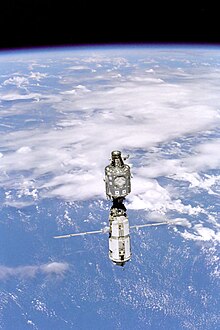STS-96
| Mission emblem | |||
|---|---|---|---|

|
|||
| Mission dates | |||
| Mission: | STS-96 | ||
| COSPAR-ID : | 1999-030A | ||
| Crew: | 7th | ||
| Begin: | May 27, 1999, 10:49:42 UTC | ||
| Starting place: | Kennedy Space Center , LC-39B | ||
| Space station: | ISS | ||
| Coupling: | May 29, 1999, 04:23 UTC | ||
| Decoupling: | June 3, 1999, 10:39 PM UTC | ||
| Duration on the ISS: | 5d 18h 15min | ||
| Number of EVA : | 1 | ||
| Landing: | June 6, 1999, 06:02:43 UTC | ||
| Landing place: | Kennedy Space Center, Lane 15 | ||
| Flight duration: | 9d 19h 13min 57s | ||
| Earth orbits: | 154 | ||
| Track height: | 320 km | ||
| Covered track: | 6.0 million km | ||
| Team photo | |||
 v. l. No. front: Kent Rominger, Ellen Ochoa, Rick Husband; back: Daniel Barry, Julie Payette, Valeri Tokarew, Tamara Jernigan |
|||
| ◄ Before / After ► | |||
|
|||
STS-96 ( english S pace T ransportation S ystem ) is the mission designation for a flight of the US Space Shuttle Discovery ( OV -103) of NASA . The launch took place on May 27, 1999. It was the 94th space shuttle mission, the 26th flight of the space shuttle Discovery and the second flight of a shuttle to the International Space Station (ISS).
team
- Kent Rominger (4th space flight), commander
- Rick Husband (1st space flight), pilot
- Daniel Barry (2nd spaceflight), mission specialist
- Tamara Jernigan (5th space flight), mission specialist
- Ellen Ochoa (3rd space flight), Mission Specialist
-
Julie Payette (1st Space Flight), Mission Specialist ( CSA / Canada )


-
Valeri Tokarew (1st space flight), mission specialist ( Roskosmos / Russia )

Mission description
The Discovery brought more than 2.1 tons of equipment to the construction site of the International Space Station (ISS). In addition, various maintenance and repair work was carried out in both modules. First, the shuttle coupled to the station on May 29, 1999 at the Unity module . The spacecraft approached the station from above.
The following day, Jernigan and Barry got off the shuttle for 7 hours and 55 minutes and installed two cranes ( Strela and ORU, respectively), which were needed to move larger loads when expanding the station. In addition, two small, portable platforms were installed on which future outboard fitters can safely stand. They are provided with holders for the shoes of the spacesuits. Finally, several tool bins were attached, a thermal cover installed and an antenna for the Early Communication System checked. The materials were housed in a special container in the Discovery's cargo bay.
On May 31, the hatches between Discovery and ISS were opened. On the following days, around 1.8 tons of equipment, water and furnishings were transported from the SpaceHab double module in the Discovery's cargo bay to the space station. This included shelf parts, clothing, food, sleeping bags and medical equipment. At the same time, additional soundproofing was installed on the ventilation system of the Sarja module, charge control devices on batteries were replaced, the energy supply for the Early Communication System was replaced, air filters were cleaned and smoke detectors were checked.
On June 3, the orbit of the space station complex was raised using the Discovery's engines. Then the space shuttle uncoupled and circled the station again. Two days later, on June 5, the STARSHINE (Student Tracked Atmosphere Research Satellite for Heuristic International Networking Equipment) small satellite was launched. This was a 50 centimeter large hollow sphere made of aluminum, which was pasted with small mirror elements. More than 25,000 students from 18 countries had polished the 900 or so aluminum mirrors that gave the satellite the appearance of a disco ball. The students followed the satellite's orbit from Earth and calculated the density of the atmosphere at high altitudes from the data. After eight months, STARSHINE entered the denser layers of the atmosphere on February 18, 2000 and burned up during its 4212th orbit.
The Discovery landed in Florida at night.
See also
Web links
- NASA Mission overview (English)
- Video summary with comments of the crew (English)
- NASA website of the Mission (English)
- NASA video of Mission (English)


